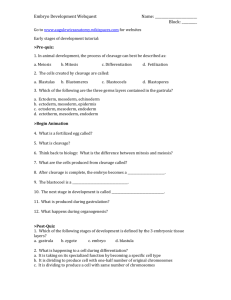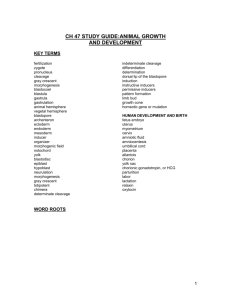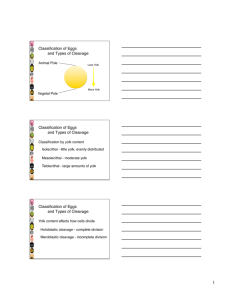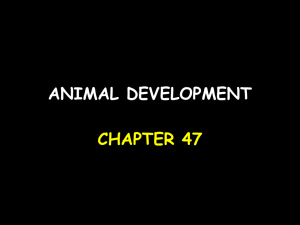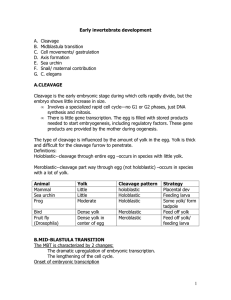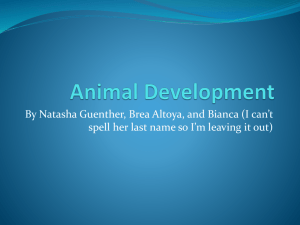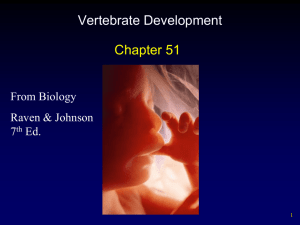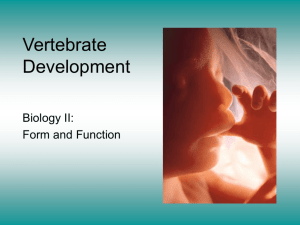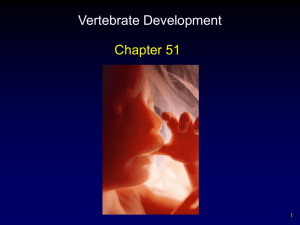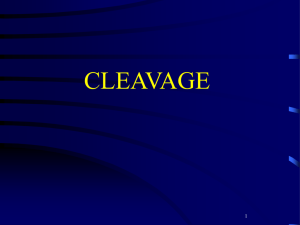Animal Embryonic Development
advertisement
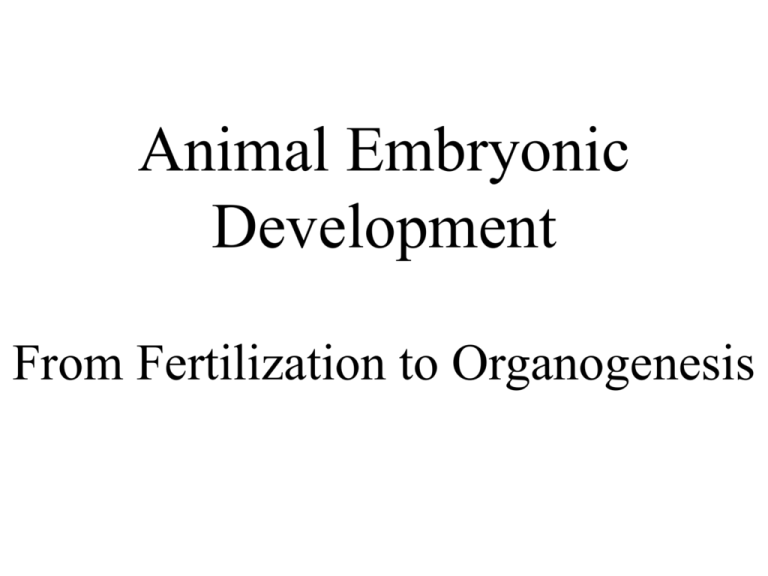
Animal Embryonic Development From Fertilization to Organogenesis Early Stages of Development • • • • Fertilization Cleavage Gastrulation Neurulation Figure 20.1 Fertilization • unequal gamete contributions – egg contributes • nutrients • proteins, mRNAs • mitochondria • essential developmental genes (imprinted) – sperm contributes • centriole • tubulin • essential developmental genes (imprinted) Fertilization • rearrangements of egg cytoplasm – egg contents are distributed heterogeneously – frog model system • animal hemisphere –contains nucleus –heavily pigmented cortical cytoplasm –lightly pigmented inner cytoplasm • vegetal hemisphere –contains nutrients –unpigmented formation of the gray crescent Figure 20.2 Fertilization • rearrangements of egg cytoplasm – imposes bilateral symmetry on egg • site of sperm entry –head (anterior) end –ventral region • gray crescent –tail end –dorsal region • (hence) left-right axis -catenin GSK-3 molecular events during rearrangement Figure 20.3 Cleavage - blastulation • rapid cell divisions – divisions oriented in specific directions • little gene expression • little cell growth • packaging of cytoplasmic heterogeneity • final product is a hollow ball of cells = blastula – cells = blastomeres – hollow cavity = blastocoel Cleavage - blastulation • yolky eggs alter pattern of divisions – animal hemisphere divides normally – vegetal (yolky) hemisphere • divides less often • produces larger cells yolk affects the cleavage pattern Figure 20.4 Cleavage - blastulation • amount of yolk affects cleavage pattern – if yolk is divided into cells • complete cleavage – if yolk is not divided • incomplete cleavage • embryo is a blastodisc atop the intact yolk formation of blastodisc Figure 20.4 Mammalian Cleavage • in oviduct • slow cell divisions • asynchronous cell divisions mammalian cleavage is rotational Figure 20.5 Mammalian Cleavage • • • • • in oviduct slow cell divisions asynchronous cell divisions accompanied by gene expression produces a blastocyst – inner cell mass - primordial embryo – trophoblast - primordial placenta component formation of mammalian blastocyst Figure 20.5 frog blastula fate map Figure 20.6 Fate Maps • undifferentiated cells of blastula have distinct fates – determination fixes fates of blastomeres • early determination yields mosaic development –a lost blastomere causes a lost body part • later determination yields regulative development –a lost blastomere is compensated during development humans exhibit regulative development Figure 20.7 Gastrulation-organizing the body plan • undifferentiated cells produce germ layers – ectoderm - prospective epidermis, nervous system – endoderm - prospective gut tissues – mesoderm - prospective organs, etc. • germ layers migrate to new positions • contact between layers allows inductive interactions to direct differentiation vegetal cells form 1˚ mesenchyme sea urchin involution Figure 20.8 vegetal pole flattens prospective ectoderm, endoderm & mesoderm are formed involution of a tube of cells primitive gut (archenteron) is formed Gastrulation-organizing the body plan • blastopore becomes mouth or anus – mouth in protostomes – anus in deuterostomes Gastrulation-organizing the body plan • frog model system – gastrulation begins at gray crescent – “bottle cells” bulge into blastocoel & pull neighbors along – initial involution forms the dorsal lip of the blastopore (d.l.b.) – epiboly • surface cell layers migrate to blastopore • migrating cells form endoderm, mesoderm frog gastrulation Figure 20.9 Figure 20.12 gray crescent is necessary for normal development Figure 20.10 Gastrulation-organizing the body plan • frog model system – ß-catenin activates genes to produce proteins that cause bottle cells to initiate involution – cells of the gastrula are determined during migration over the d.l.b. • dlb is necessary for normal development • dlb is sufficient for normal development role of dlb in development in frog Figure 20.11 Gastrulation-organizing the body plan • reptile/bird model – two-layered blastodisc + large yolk mass • upper layer –epiblast –becomes embryo • lower layer –hypoblast –becomes extra-embryonic membranes chick gastrulation Figure 20.13 early mammalian gastrulation Figure 20.14 Neurulation • organogenesis – formation of organs and organ systems – caused by inductive interactions among germ layers frog neurulation Figure 20.15 Neurulation • vertebrate body segmentation – alongside neural tube • segments of mesoderm = somites • somites direct development of vertebrae, ribs, trunk muscles, limbs, outgrowth of nerves, blood vessels, etc • repeated segments are modified along the anterior/posterior axis somites contribute to vertebrae, ribs & muscles neural crest cells give rise to peripheral nerves Figure 20.16 HOX genes control anterior-posterior differentiation • families of ~10 HOX genes are on different chromosomes • HOX genes are expressed “in order” • HOX genes guide differentiation from anterior to posterior mouse HOX gene clusters Figure 20.17 vertebrate extraembryonic membranes • reptiles, birds and mammals produce membranes that – surround the embryo – originate in the embryo – are not part of the embryo – provide nutrition, gas exchange and waste removal chick extraembryonic membranes Figure 20.18 shell lining embryo compartment pantry waste storage placenta: chorion + uterine tissues Figure 20.19
